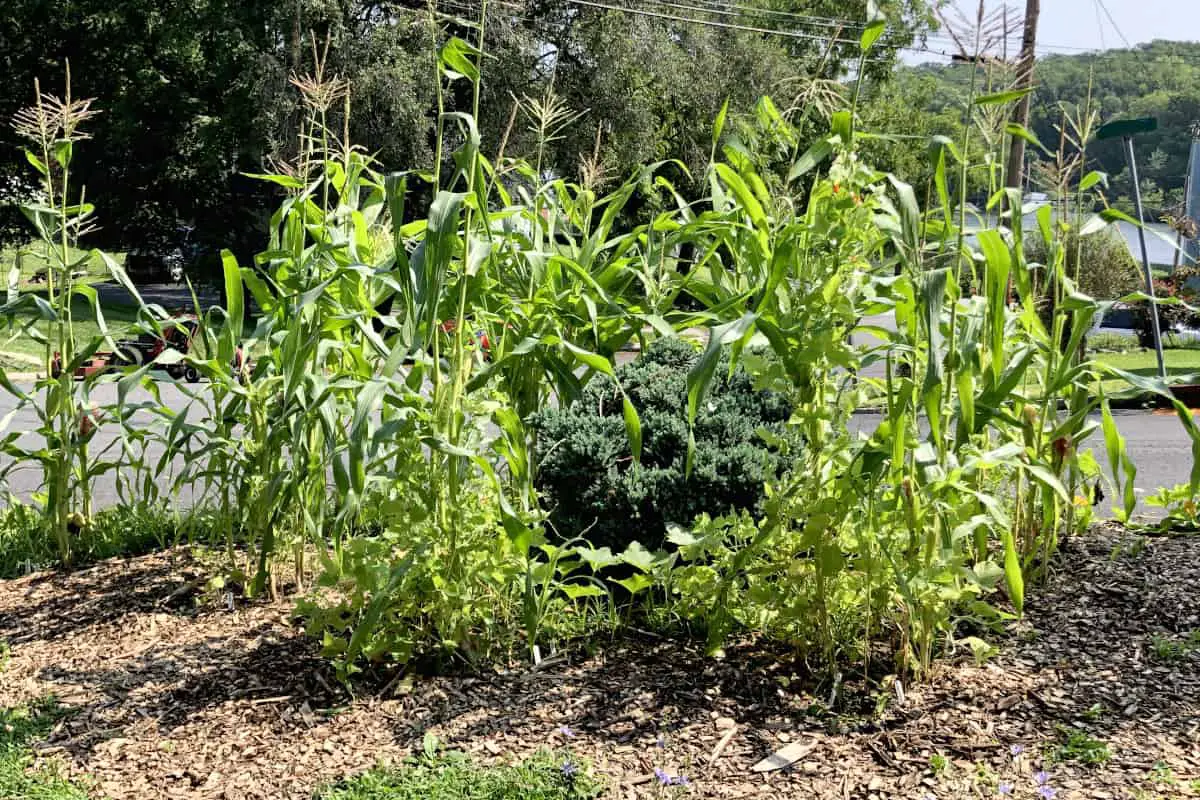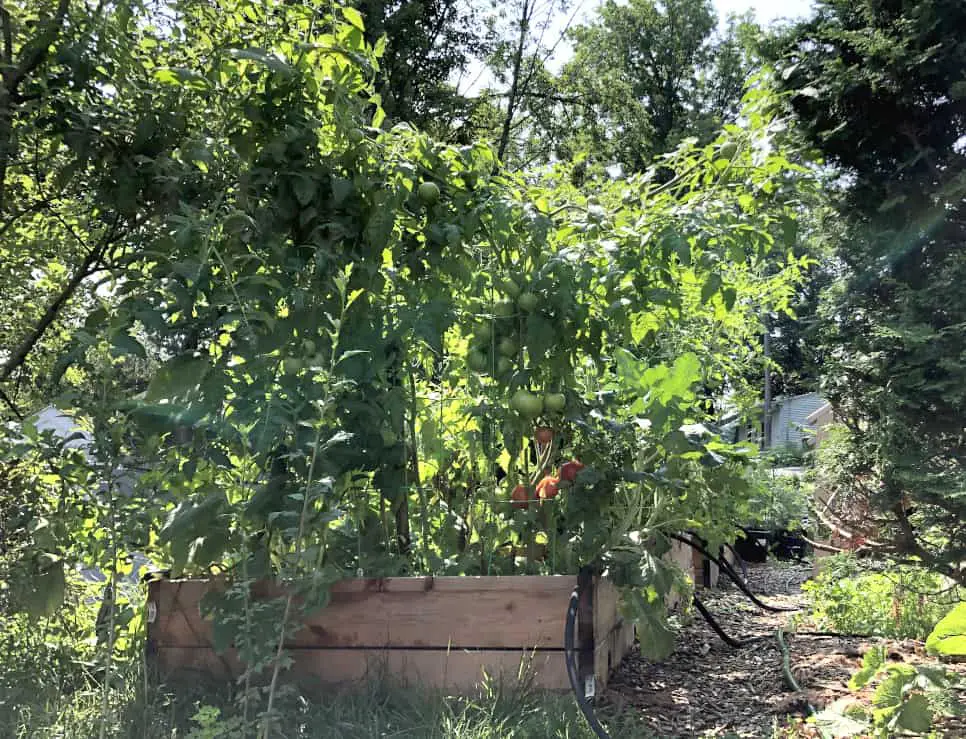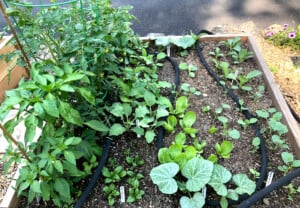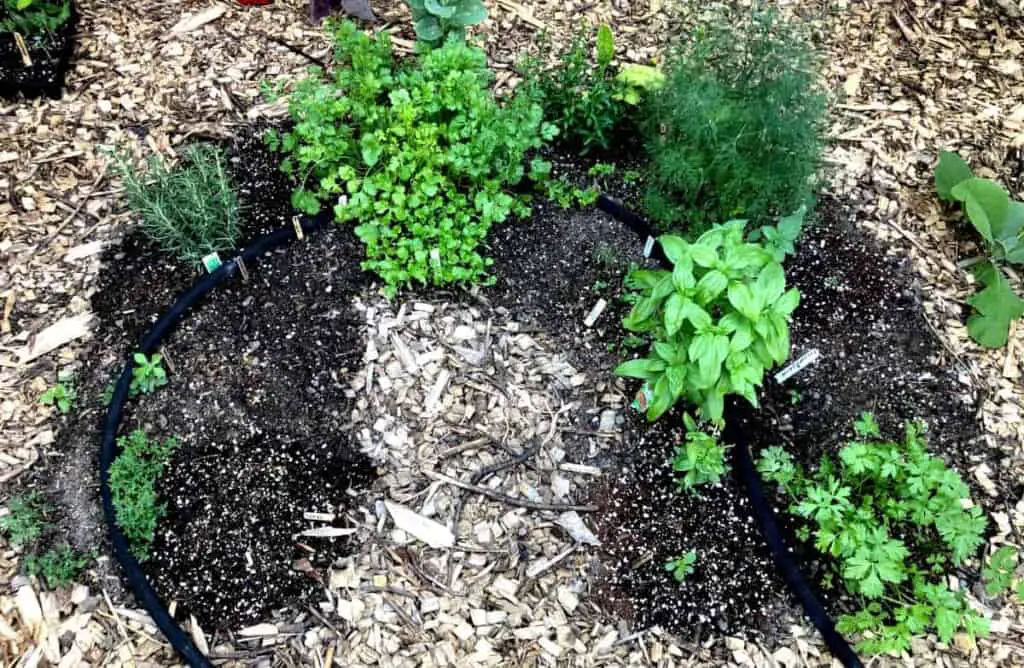After you have chosen a location suitable for your garden, it’s time to prepare a vegetable garden layout. If you still need to get into selecting the best site for your garden, I invite you to read my article How to plan a vegetable garden, in which I name key factors to select the best possible garden site for you. My growing space is not one continuous space. Being located on a slope, I converted multiple spots on my property into several gardening spaces. But there are a few key rules I always observe no matter where my garden lies.
To prepare a vegetable garden layout place your garden raised beds, containers, or rows from south side to north side for best sun exposure, put the whole layout on paper first so you can review it from the bird’s perspective and see if there is anything you missed or could improve. When planting vegetables, plant the tallest ones on the north side or the back of the garden bed, then medium size plants in front of the tall ones, and the shortest in front of the medium ones. Thus the tall plants won’t be overshadowing the shorter plants, but each plant will get the most sun. If you place your garden beds south to north, tallest towards the north, and shortest plants towards the south your tall plants will not cast shadows on the short ones, they will cast shadows out of the garden bed.

Place garden beds from south to north
In general, if your garden lays on the south side of the property and there are no obstacles that would cast a shadow into your growing space then lay your garden beds south to north for the best sun exposure. However not all of us have the luxury of an ideal property for growing vegetables, so we have to work with what we have got. Observe your property in the morning, noon, and afternoon, and notice the space where you can find sun all day. This would be the best spot for your vegetable garden since it gets the best sun exposure.
If you see there are trees, houses, and fences that cast shadows, and you are not able to avoid them, then work with them. I lay my garden beds in my main garden on the south side from south to north. Sun travels across my garden from East to West and the south side of the property gets sun the whole day long.
When planning your garden beds, you can choose from the 3 most used garden types for vegetable gardens. You can either lay your beds directly in the ground which is called an in-ground garden or lay them on top of the ground using raised beds. The third type is container gardening where containers are used to grow vegetables in. To grasp each garden type for vegetables in detail go, to What is the best type of garden for vegetables? this article will give you the best chance to choose the garden type that would work best for your property.

Plant your plants in the correct layout
If I position my garden beds from south to north, then I am able to plant the tallest plants always on the north side-the back of the garden bed, then mid-size plants in front of the tall plants, and short plants in front of the mid-size ones. Planting in such a layout allows the sun to travel through the sky while providing all my plants with an equal amount of sun exposure. My tall plants cast shadows either outside of the garden or on the garden paths. The tall plants don’t overshadow my shorter plants, and all of them get the maximum sunlight.

I plant my trees on the north side or next to the fence of my property, where my neighbor’s trees already are, and thus would cast a shadow into my growing space later afternoon anyway.
Draw your vegetable garden layout on paper
After your garden observation, draw the simple layout of your garden on paper so you could see it from a bird’s view and notice what it would look like and if there is anything you could improve, add, or would have to take away. Simply drawing your garden layout should help you better imagine the finished product and avoid potential mistakes. Is there a shad you missed that would cast a shadow in the midday, or stairs that would be an obstacle to entering your garden, so you need to rethink the entry? Is your garden too far from the water source? Is there a slope you need to work with? You can address all these issues on paper first before you act and put yourself hard to work.
There will always be something that might surprise us when we are directly in the terrain, so be open-minded to change a couple of things if they are different from your drawing. It’s totally OK.
I keep my finished compost outside of my garden simply because my main garden space is not big enough to contain it. My cold compost pile is located also outside of the garden space because I don’t want anything dead and decomposing in the garden. My shed is outside my main garden as well. However, if you are lucky enough to include all those inside your garden it might save you energy and workload, so don’t forget to include in your drawings other things that you would like to have in your garden such as finished compost, composter, compost pile, shed, and such.
Count with herbs in your layout
Herbs give taste to your precious food and make it extra special, delicious, and delightful to smell. I have one separate space for herbs only, I call it my herb garden. It includes mainly perennial plants such as thyme, and rosemary, biennial herbs like parsley, and herbs that need to be seeded every year but in my herbal garden, I let them do that job on their own like dill or cilantro. I have to say that I love cooking with herbs and smelling them and so I noticed that my herbal garden is expanding every year.
Some annual herbs I saw directly in garden beds to deter bad insects and, or attract the beneficial insect. Some herbs I like to plant among my vegetables, herbs like cilantro, basil, and dill. The more I sowed these, the more I use them and there is never enough of them in our house!

I not only use fresh herbs during the growing season, but I dry them simply by hanging them in a shed and storing them for winter, or whenever I need them. I saw and harvest annual herbs several times during the growing season. I also harvest thyme and rosemary several times during the growing season for drying and storage.
Do what works best for your property
As I said, we all deal with different garden sites. My site is on a slope, yours might be on the west side instead of the south, and so on. Some of us live in a windy place where the garden needs to be protected from wind gusts. As we observe our environment and location, we learn more and more about what to take into account when laying a garden. Each of us just needs to observe how the sun travels and where and when the shadow is cast and what other factors play into the role and work with what we got have to make it work for us best.
Adjust as needed when needed
I have to say, seldom a gardener gets all things just perfectly right the first time when laying a garden. So, it’s absolutely alright, and beneficial if you later catch something you didn’t notice before you started gardening and now it’s time to adjust your garden layout a bit. It’s totally normal. In my case I had to move about 5 garden beds 4×4 with all the frames and soil at one point because I observed that something was not right at the location, I placed them. I looked at it positively because I learned something I had no idea as a beginner gardener. I became a wiser, and more experienced gardener. Gardening is about the experience which comes only from doing not just from reading and listening.
Now you know what to consider when papering a vegetable garden layout and how to accomplish it. Time to get things done, happy gardening!
What is the best type of garden for vegetables?
How to start a vegetable garden

